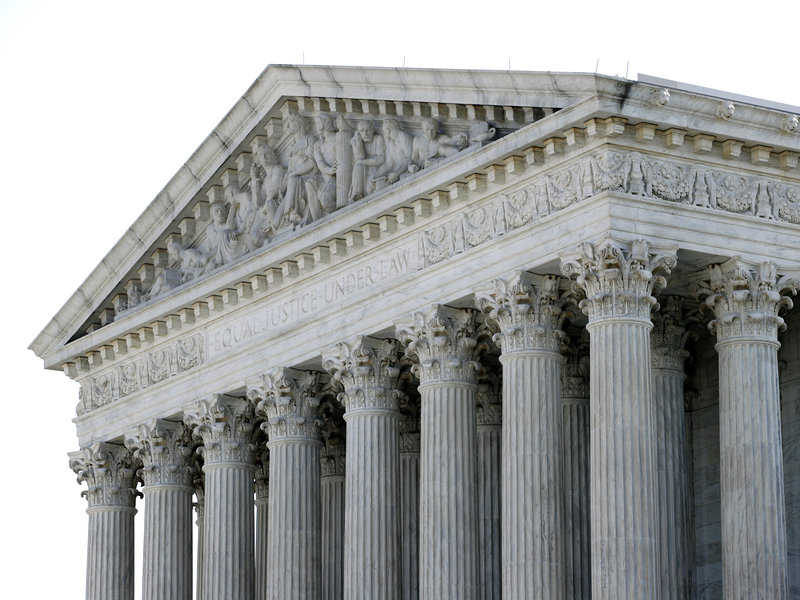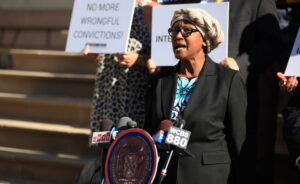
Image credit: Patrick Semansky/Associated Press
Trigger warning: mentions of murder, torture and rape
Washington D.C. – The month of July marked a grim American milestone — two federal executions, in federal prisons, within a week’s time. This hasn’t happened in 17 years. Should defendants be legally able to contest the use of federal executions? How is it legal for the government to perform federal executions through lethal injections?
Daniel Lewis Lee was executed in July 2020 for torturing and killing a family of three, as well as for dumping the bodies by a lake. Lee’s last words prior to his execution were, “I didn’t do it.” With Daniel Lee’s execution approved, a Supreme Court order was written to resume enforcement of the death penalty in the United States.
Lee’s family opposed this execution, due to his accomplice being sentenced to only life in prison in Arkansas. Daniel Lee’s counsel Ruth Friedman said, “It is a shame that an execution was carried during this pandemic and when his counsel could not be present with him.”
Ruth further added, “It is beyond shameful that the government, in the end, carried out this execution in haste, in the middle of the night, while the country was sleeping. We hope that upon awakening, the country will be as outraged as we are.”
Earlene Petterson, the grandmother, mother and mother-in-law of the victims, told the media that she did not want this execution done in her name.
Immediately after Daniel Lee’s execution, the United States saw the federal execution of Wesley Purkey in Indiana. Purkey was prosecuted for murdering and raping a 16-year-old girl in Kansas City, Missouri in 1994. This case has garnered mixed opinions from the likes of her family and lawmakers.
The victim’s family expressed relief at this execution, her father saying, “We took care of today what we needed to take care of. It has been a long time coming. He needed to take his last breath; he took my daughter’s last breath. And there’s some resolve.”
Purkey’s attorneys mentioned in the petition to vacate the sentencing: “As a child, [Purkey was] said to have experienced repeated sexual abuse and molestation by those charged with caring for him. As a young man he suffered multiple traumatic brain injuries—first in 1968, when he was 16, and again in 1976. At 18 he was diagnosed with schizophrenic reaction, schizoaffective disorder, and depression superimposed upon a pre-existing antisocial personality. At 68, he suffers from progressive dementia, schizophrenia, complex-post traumatic stress disorder, and severe mental illness.”
However, Purkey did apologize to the victim’s family before the execution.
If another execution took place that week, it would have outnumbered the federal executions that have happened in the last 15 years.
Initially, the botched execution system was facing multiple obstacles; human rights protests challenged the use of traditional execution methods, and the execution system experienced difficulty in obtaining lethal injections. Many inmates, including Lee and Purkey, sued the Justice Administration Commission, claiming it was unconstitutional. Their reasoning is that the injection very quickly fills the lungs with blood-based fluids, making the inmates unconscious.
In 2019, Attorney General Wiliam Barr moved to resume capital punishment with the use of lethal injections. After these two executions, he said, “The American people have made the…choice to permit capital punishment for the most egregious federal crimes, and justice was done today in implementing the sentence for Lee’s horrific offenses.”
According to Barr, this directive to federal prisons was for those inmates who were charged with murdering, and in many cases torturing and raping, the most vulnerable of society – children and elderly.
However, many lawmakers have opposed it, claiming that this deprives defendants of their right to challenge the constitutionality of this provision.
The Current Affairs Times has analyzed what the use of lethal injections means and how it differs from traditional execution methods:
The federal government is to adhere at least to a State’s choice among execution methods such as hanging, electrocution, or lethal injection. However here the Supreme Court chose to exercise discretion and overwrite that. The inmates challenged this method and moved for it to be unconstitutional, seeking an emergency stay order which was denied.
On three different occasions, Congress has addressed the “manner” of implementing the death penalty for federal capital offenses. The first-ever Congress specified that “the manner of inflicting the punishment of death, shall be by hanging the person convicted by the neck until dead.”
In 1937, Congress changed this rule to make the “manner” of federal executions follow state law. Specifically, Congress said, “The manner of inflicting the punishment of death shall be the manner prescribed by the laws of the State within which the sentence is imposed.”
It was only in 1993 that the Attorney General confirmed the ability to use lethal injections only through intravenous injection of a lethal substance in quantities sufficient to cause death. That directive stated that Federal Prison Bureau norms could be used and further included norms about the time and place of execution, the manner of execution and witnesses of the execution – including details of who can attend the execution.
In 2001, three federal executions occurred in a span of three years; there have never been two executions in the same week. At that time in the case of Baze v. Rees, “a combination of three lethal substances—sodium thiopental, a barbiturate that “induces a deep, comalike unconsciousness, and lethal substances—” were used. In 2017, the government announced that it would replace the old three-drug protocol with lethal injections of a single drug: pentobarbital. In the case of Daniel Lee, the victim’s family specifically asked to be present, however that request was denied because of the pandemic, and the request to delay this execution was also further denied.
To Lee and Purkey’s case, Justice Stephen Breyer wrote in his dissenting opinion, “The resumption of federal executions promises to provide examples that illustrate the difficulties of administering the death penalty consistent with the Constitution.” Should these executions be carried out after multiple years of sentencing? When the inmate has no consciousness?
Do these executions give these inmates what they deserve no matter what, and finally bring justice to the families of the victims?
There are now two other prisoners scheduled to be executed with this method. What happened with the victims was extremely sad; however, the defendants deserved the greatest degree of punishment if they did commit the crimes they have been charged with. Are federal executions the most effective, concise, legal manner of serving justice, or does it strip inmates of their right to challenge the constitutionality of such execution? Is mental competency necessary or is it only a shortcut to obtain judicial review?
Image credit: Patrick Semansky/Associated Press
Sources:
- The Current Affairs Times utilizes the Westlaw Edge database as insight for the research in this article. Please contact the Current Affairs Times if you would like access to this research.
- Reuters.
- 18 U.S.C.A. § 3596(a).
- The Wall Street Journal.
Afia is a lawyer, journalist, an avid traveler, an avid reader, a foodie, and an amateur singer. She enjoys instrumental music with her glass of wine ?



